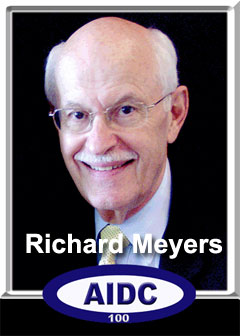SCDigest
Editorial Staff
| SCDigest Says: |
 Improvements in printer and scanner quality and capabilities, and knowledge about bar code media and related issues, have in general made the technical performance problems a rare issue. Improvements in printer and scanner quality and capabilities, and knowledge about bar code media and related issues, have in general made the technical performance problems a rare issue.

Click Here to See Reader Feedback |
A strange as it may seem for today's generation, in the early days of bar coding (1980s and through much of the 1990s), the technology had many pit falls and companies often ran into many problems with bar code quality, scannability, label appropriateness and other issues that caused real problems with their ability to consistently read bar code symbols correctly.
For example, SCDigest editor Dan Gilmore says he worked on an automated distribution center that relied on scanning an "I 2 of 5" case code to trigger automated print and apply of a serialized bar code label for sortation purposes - but that the I 2 of 5 labels printed as part of the production process had serious quality errors that made them unuasable. The company has to re-apply the labels in distribution, at enormous costs.
Today, improvements in printer and scanner quality and capabilities, and knowledge about bar code media and related issues, have in general made the technical performance problems a rare issue.
Richard Meyers, one of the most recognized figures in the bar code industry during that time and charter member of the "AIDC 100", developed in the mid-1980s a list of "Bar Code 10 Commandments" useful for avoiding the most common implementation problems. He delivered presentations on this list at dozens of industry events for more than a decade after that, heard by literally thousands of people hoping to avoid their own "bar code bloopers" (the title of another often delivered presentation of the era).
SCDigest caught up with Meyers at his Florida home, and he sent us a copy of a long article on the 10 Commandments. Below, you will find a condensed and slightly edited version.
Are any of the commandments still relevant today? You can judge for yourself, but certainly things like paying close attention to the media used and thinking about numbering schemes will always have a place.
The rest seem not too compelling today, but left us wondering whether we need a similar set of commandments for the still little understood area of RFID. Have any suggestions there? Send them to us at the Feedback button at the bottom of the page.
Take a look at the commandment below. Will be a trip down memory lane for those involved in those exciting days back then.
Commandment 1: Use Low Density Codes
Density or Characters Per Inch (CPI) will directly result from the size of narrow plus wide bars and spaces (elements) used to configure each symbol. The wider the bars/spaces, the lower the density. Narrower bars/spaces will result in higher density, reducing the size of the symbol, but can also be more difficult to scan depending upon the environment.
KEY POINT: The scanner looks at the pattern of bars and spaces in a similar manner as the human eye. Wider bars/spaces are easier to interpret and less subject to hostile conditions like voids and specks of dirt, etc. For the most effective and reliable scanning, implement with the lowest possible density. There will be applications that demand the use of high density media. In these situations, more sophisticated and/or expensive scanning solutions may be required that will provide satisfactory results.
Commandment 2: Use a High Wide-to-Narrow Element Ratio
Every linear bar code symbology includes a series of narrow and wide bars/spaces (elements) that make up the final configuration.
Depending on the "X" factor (size of narrowest element), the dimension of the wide element can be in a range of 2 to 3 times "X". Also, as a result of the printing process, bars and spaces can be thicker or thinner than intended. This variation is satisfactory as long as each element is within certain tolerance ranges.
If a 2:1 ration of wide to narrow is used, in some cases the size of the wide and narrow bars becomes almost indistinguishable.
KEY POINT: Although some Code 39 applications will dictate the use of a low ratio, the most effective and reliable scanning takes place with a wide-to-narrow element ratio as close to 3 to 1 as possible. Code 128 and UPC/EAN are configured with four specific wide-to-narrow ratios so there is no option with those symbologies.
Commandment 3: Use Carbon-based Ink
 Bar code scanning takes place by focusing light on a pattern of bars and spaces. The bars should absorb most of the light and the spaces should reflect most of the light back to the scanning device. The two primary ways of measuring the correct absorption and reflection factors is by Print Contrast Signal (PCS) or Minimum Reflectance Difference (MRD). The result of these calculations must be substantial enough that scanners are able to properly distinguish between bars and spaces. Bar code scanning takes place by focusing light on a pattern of bars and spaces. The bars should absorb most of the light and the spaces should reflect most of the light back to the scanning device. The two primary ways of measuring the correct absorption and reflection factors is by Print Contrast Signal (PCS) or Minimum Reflectance Difference (MRD). The result of these calculations must be substantial enough that scanners are able to properly distinguish between bars and spaces.
KEY POINT: Although not mandatory, the use of carbon-based inks will often provide superior scanning performance. Some hostile conditions will dictate this technique. A number of industry standards require the use of carbon-based media. A major exception is the retail food industry. In this case, the printing of UPC symbols on product packages with carbon inks would add excessive cost to the process.
Commandment 4: Ignore the Media at your Scanning Peril
All too often this topic is a step-child, the last to get recognition in the implementation process. Media substrate (the printing surface) and adhesive backing problems can and should be avoided. The challenges are relatively simple.
Opacity must be sufficient to prevent background surfaces from interfering with the scanners ability to read the media. If a dark background shows through a label, the scanner may interpret some spaces as bars. This condition can readily happen when a white adhesive label is placed on a dark surface.
A wide variety of other media issues and choices can lead to problems. For example, bar coded media that will be exposed to hostile conditions, like humidity and temperature extremes, should be pre-tested before a final substrate decision is made. Many companies have used the wrong label adhesive and had the labels not stick over time to the item or surface to which they are applied.
KEY POINT: Rarely has an application been found for which there is no right media solution. Define the label requirements including shelf life (after printing), the number of times to be scanned and the scanning environment. Then seek proper counsel with a reputable source who uses the latest techniques and provides guidance on the proper marriage of various media supplies.
Commandment 5: Use Bar Code Verification System when Printing
Many installations witness the creation of labels, and the placement of those labels on objects that are then transported to a destination commonly known as a scanning station. Voila! The scanner doesn't scan or the scanner scans bad data or bad data results from scanning. Why?
Unfortunately, printed media is rarely checked before entering the system flow. The quality of both code and data has the potential of being part of the problem as opposed to being part of the solution.
Bar code quality can be achieved with the use of readily available verification or analyzer hardware. This function should be performed on a random basis or, if important enough, on every label.
KEY POINT: A significant majority of bar code implementation problems can be traced back to the lack of a verification process. Whether generating media for internal or external purposes, QUALITY COMPLIANCE (QC) will be achieved by making verification a part of the process. Do it manually on a random basis or, do it with sophisticated equipment. Regardless of the chosen method, DO IT!
Commandment 6: Match Scanner Resolution and Media Density
The second largest problem observed at user locations is the failure to match the resolution of the scanner to the density (CPI) of the media. Stated another way, the size of the spot of light coming out of a scanning device should be slightly less than the narrowest element ("X" dimension). The second largest problem observed at user locations is the failure to match the resolution of the scanner to the density (CPI) of the media. Stated another way, the size of the spot of light coming out of a scanning device should be slightly less than the narrowest element ("X" dimension).
If the scanner resolution or spot of light is significantly smaller than the narrowest element, scanning is not only difficult but errors can readily occur.
However, moving-beam laser scanners are much more forgiving than earlier forms pof bar code scanning.
KEY POINT: For the most effective and reliable scanning, be certain that the resolution of either contact or non-contact devices be matched properly to the narrowest element of any one symbol. If there are applications that demand the scanning of a wide variety of narrow elements, non-contact scanners may be required.
This RFID-Auto ID Story is Continued Below
|